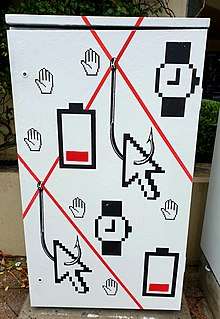Clickbait
Clickbait, a form of false advertisement, uses hyperlink text or a thumbnail link that is designed to attract attention and to entice users to follow that link and read, view, or listen to the linked piece of online content, with a defining characteristic of being deceptive, typically sensationalized or misleading.[2][3] A "teaser" aims to exploit the "curiosity gap", providing just enough information to make readers of news websites curious, but not enough to satisfy their curiosity without clicking through to the linked content. Click-bait headlines add an element of dishonesty, using enticements that do not accurately reflect the content being delivered.[4][5][6] The "-bait" part of the term makes an analogy with fishing, where a hook is disguised by an enticement (bait), presenting the impression to the fish that it is a desirable thing to swallow.
Long before the Internet, an unscrupulous marketing practice known as bait-and-switch used similar dishonest methods to hook customers. Like bait-and-switch, clickbait is a form of fraud. (Click fraud, however, is a separate form of online misrepresentation which uses a more extreme disconnect between what is being presented in the frontside of the link versus what is on the click-through side of the link, also encompassing malicious code.) The term clickbait does not encompass all cases where the user arrives at a destination that is not anticipated from the link that is clicked. When the manipulation is done for the purpose of humor, as with rickrolling, and there is no element of exploitation, then that deception does not qualify as clickbait. The term can also be misused when viewers complain about an enticing thumbnail or title, as with a sexually provocative image. But if the image or title accurately reflects the content delivered upon click-through, then this is an example of simple enticement. Without the element of deception, it does not qualify as clickbait. The borderline cases happen when a content creator inserts a very short segment in order to serve as justification for a provocative thumbnail, when the vast majority of the content has nothing to do with this short segment or thumbnail. Here, a strong case for clickbait can be made by any user, as the overriding characteristic is deception for the purpose of exploiting the user.
Definition
A defining characteristic of clickbait is misrepresentation in the enticement presented to the user to manipulate them to click onto a link. While there is no universally agreed-upon definition of clickbait, Merriam-Webster defines clickbait as "something designed to make readers want to click on a hyperlink, especially when the link leads to content of dubious value or interest."[7] Dictionary.com is states that clickbait is "a sensationalized headline or piece of text on the Internet designed to entice people to follow a link to an article on another web page."[8]
BuzzFeed editor Ben Smith states that his publication doesn't do clickbait, using a strict definition of clickbait as a headline that is dishonest about the content of the article. Smith notes that Buzzfeed headlines such as "A 5-Year-Old Girl Raised Enough Money To Take Her Father Who Has Terminal Cancer To Disney World" deliver exactly what the headline promises. The fact that the headline is written to be eye-catching is irrelevant in Smith's view since the headline accurately describes the article.[9]
Facebook, while trying to reduce the amount of clickbait shown to users, defined the term as a headline that encourages users to click, but doesn't tell them what they will see. However, this definition excludes a lot of content that is generally regarded as clickbait.[3]
A more commonly used definition is a headline that intentionally over-promises and under-delivers.[10] The articles associated with such headlines often are unoriginal, and either merely restate the headline, or copies content from a more genuine news source.
The term clickbait is sometimes used for any article that is unflattering to a person. In such cases, the article is not actually clickbait by any legitimate definition of the term.[11]
Background
From a historical perspective, the techniques employed by clickbait authors can be considered derivative of yellow journalism, which presented little or no legitimate well-researched news and instead used eye-catching headlines that included exaggerations of news events, scandal-mongering, or sensationalism.[12][13] One cause of such sensational stories is the controversial practice called checkbook journalism, where news reporters pay sources for their information without verifying its truth. In the U.S. it is generally considered an unethical practice, as it often turns celebrities and politicians into lucrative targets of unproven allegations.[14] According to Washington Post writer Howard Kurtz, "this thriving tabloid culture has erased the old definitions of news by including tawdry and sensational stories about celebrities for the sake of profit."[14]
Use
Clickbait is primarily used to drive page views on websites,[15] whether for their own purposes or to increase online advertising revenue.[16] It can also be used for phishing attacks for the purpose of spreading malicious files or stealing user information.[17] The attack occurs once the user opens the link provided to learn more. Clickbait has also been used for political ends and has been blamed for the rise of post-truth politics. Katherine Viner, editor-in-chief at The Guardian wrote that "chasing down cheap clicks at the expense of accuracy and veracity" undermined the value of journalism and truth.[18] Emotional subjects with stark headlines are widely shared and clicked, which resulted in what Slate described as an "aggregation of outrage" and a proliferation of websites across the political spectrum – including Breitbart News, Huffington Post, Salon, Townhall and the Gawker Media blogs – which profited by producing shareable short-form pieces offering simple moral judgements on political and cultural issues.[19]
There are various clickbait strategies, including the composition of headlines of news and online articles that build suspense and sensation, luring and teasing users to click.[20] Some of the popular approaches in achieving these include the presentation of link and images that are interesting to the user, exploiting curiosity related to greed or prurient interest.[17] It is not uncommon, for instance, for these contents to include lewd image or a "make money quick" scheme.[17]
Backlash

By 2014, the ubiquity of clickbait on the web had begun to lead to a backlash against its use.[6][21] Satirical newspaper The Onion launched a new website, ClickHole, that parodied clickbait websites such as Upworthy and BuzzFeed,[22] and in August 2014, Facebook announced that it was taking technical measures to reduce the impact of clickbait on its social network,[23][24][25] using, among other cues, the time spent by the user on visiting the linked page as a way of distinguishing clickbait from other types of content.[26] Ad blockers and a general fall in advertising clicks also affected the clickbait model, as websites moved toward sponsored advertising and native advertising where the content of the article was more important than the click-rate.[19]
As problem attracted interest, tools have been developed to address the clickbait problem. Clickbait detection, for instance, has been integrated in browser applications while digital platforms where contents are shared such as Twitter have updated their respective algorithms to filter clickbait contents.[27] Social media groups, such as Stop Clickbait,[28][29][30][31] combat clickbait by giving a short summary of the clickbait article, closing the "curiosity gap". Clickbait reporting browser plug-ins[32] have been also developed by the research community in order to report clickbait links for further advances in the field based on supervised learning algorithms. Security software providers offer advice on how to avoid harmful clickbait.[33]
See also
| Look up clickbait in Wiktionary, the free dictionary. |
- Betteridge's law of headlines – An adage that states: "Any headline that ends in a question mark can be answered by the word no."
- Sticky content
- Viral marketing – Marketing strategy that uses existing social networks to promote a product
- Yellow journalism – Sensationalistic news
- Media manipulation
- Chumbox – Form of online advertising
- Display advertising
References
- Gardiner, Bryan (December 18, 2015). "You'll Be Outraged At How Easy It Was To Get You To Click On This Headline". Wired. Retrieved 2 August 2018.
- Frampton, Ben (14 September 2015). "Clickbait - the changing face of online journalism". BBC. Retrieved 12 June 2018.
Headline writing has long been considered a skill but, in the digital age, a new word has become synonymous with online journalism - clickbait.
Put simply, it is a headline which tempts the reader to click on the link to the story. But the name is used pejoratively to describe headlines which are sensationalised, turn out to be adverts or are simply misleading. - O'Donovan, Caroline. "What is clickbait?". Nieman Foundation for Journalism. Niewman labs. Retrieved 12 June 2018.
Clickbait is in the eye of the beholder, but Facebook defines it as 'when a publisher posts a link with a headline that encourages people to click to see more, without telling them much information about what they will see.'
- Derek Thompson (November 14, 2013). "Upworthy: I Thought This Website Was Crazy, but What Happened Next Changed Everything". The Atlantic.
- Katy Waldman (May 23, 2014). "Mind the 'curiosity gap': How can Upworthy be 'noble' and right when its clickbait headlines feel so wrong?". National Post.
- Emily Shire (14 July 2014). "Saving Us From Ourselves: The Anti-Clickbait Movement". The Daily Beast.
- "Definition of CLICKBAIT". www.merriam-webster.com. Retrieved 2019-04-19.
- Smith, Ben (November 6, 2014). "Why BuzzFeed Doesn't Do Clickbait". BuzzFeed. Retrieved January 16, 2019.
- "WTF is clickbait?". TechCrunch. Retrieved 2019-01-16.
- Bowles, Nellie (2016-05-27). "What Silicon Valley's billionaires don't understand about the first amendment | Nellie Bowles". The Guardian. ISSN 0261-3077. Retrieved 2019-01-16.
- Ingram, Mathew (1 April 2014). "The internet didn't invent viral content or clickbait journalism — there's just more of it now, and it happens faster". GigaOM. Retrieved 6 August 2016.
- Drell, Cady (29 July 2016). "How Son of Sam Changed America". Rolling Stone. Retrieved 6 August 2016.
- Kurtz, Howard. "Fees for Sleaze", Washington Post, Jan. 27, 1994
- "WTF is clickbait?". TechCrunch. Retrieved 2020-07-22.
- Frampton, Ben (2015-09-14). "Is clickbait changing journalism?". BBC News. Retrieved 2020-07-22.
- Bryant, Adam; Lopez, Juan; Mills, Robert (2017). Proceedings of the 12th International Conference on Cyber Warfare and Security. Reading, UK: Academic Conferences and Publishing Limited. p. 27. ISBN 9781911218258.
- Katherine Viner (12 July 2016). "How technology disrupted the truth". The Guardian. Retrieved 12 July 2016.
- David Auerbach (10 March 2015). "The Death of Outrage". Slate. Retrieved 6 August 2016.
- Chen, Lei; Jensen, Christian; Shahabi, Cyrus; Yang, Xiaochun; Lian, Xiang (2017). Web and Big Data: First International Joint Conference, APWeb-WAIM 2017, Beijing, China, July 7–9, 2017, Proceedings, Part 2. Cham: Springer. p. 73. ISBN 9783319635637.
- Christine Lagorio-Chafkin (Jan 27, 2014). "Clickbait Bites. Downworthy Is Actually Doing Something About It". Inc.
- Oremus, Will (2014-06-19). "Clickhole: The Onion's new site is more than a BuzzFeed parody". Slate.com. Retrieved 2017-02-24.
- Lisa Visentin (August 26, 2014). "Facebook wages war on click-bait". The Sydney Morning Herald.
- Andrew Leonard (Aug 25, 2014). "Why Mark Zuckerberg's war on click bait proves we are all pawns of social media". Salon.
- Khalid El-Arini and Joyce Tang (August 25, 2014). "News Feed FYI: Click-baiting". Facebook Inc.
- Ravi Somaiya (August 25, 2014). "Facebook Takes Steps Against 'Click Bait' Articles". The New York Times.
- Hung, Jason; Yen, Neil; Hui, Lin (2018). Frontier Computing: Theory, Technologies and Applications (FC 2017). Singapore: Springer. p. 133. ISBN 9789811073977.
- Greta J. "10+ Times 'Stop Clickbait' Hilariously Summarized Crappy Articles And Saved You A Click".
- "Stop Clickbait". Know Your Meme.
- KUSA Staff (2017-05-19). "What this CU student is doing about clickbait will surprise you!".
- "This Article About Stopping Clickbait Isn't Clickbait. We Promise".
- Darius Bufnea and Diana Șotropa (September 2018). "A Community Driven Approach for Click Bait Reporting". 2018 26th International Conference on Software, Telecommunications and Computer Networks (SoftCOM). IEEE. pp. 1–6. doi:10.23919/SOFTCOM.2018.8555759. ISBN 978-9-5329-0087-3.
- "Top 10 Internet Safety Rules & What Not to Do Online". usa.kaspersky.com. Retrieved 2020-05-04.
